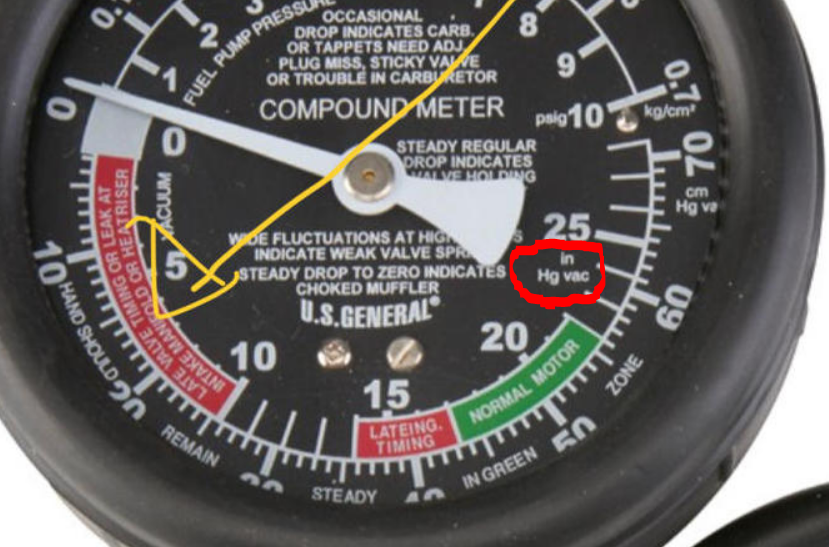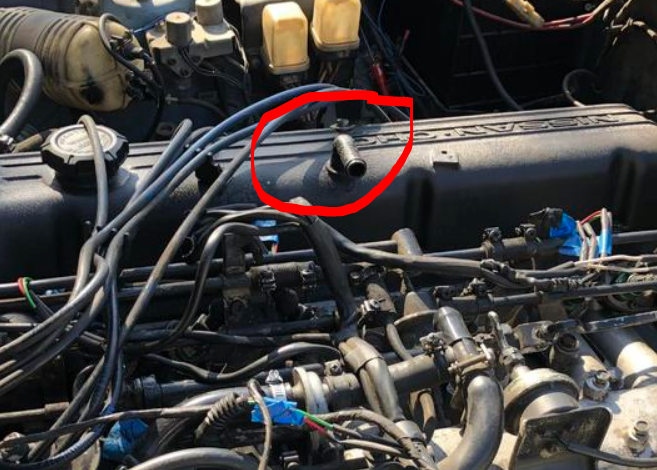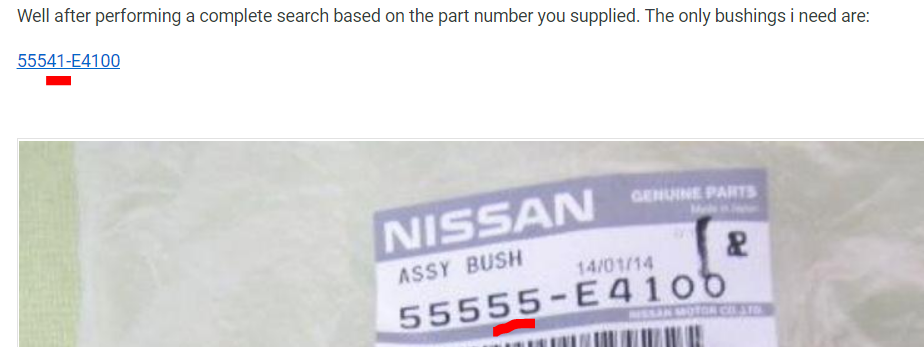Everything posted by Zed Head
-
Idle problems.
That's inches of vacuum, a 0 - 28 scale, in mercury (Hg). A very low number. Looks like a big leak somewhere. Just stare at the engine and all of the various hoses and fittings on the intake system and the engine's crank case. Wiggle things while it's running, squirt some carb cleaner. You'll find something. Post a picture and we'll mark it up with places to look. At least it runs. Once you get the leaks sealed up the idle screw should work.
-
Transistor Module swap *PLS HELP*
Not sure what to recommend here. I've offered ideas but then you do something else instead. Did you swap G and W? Not clear what the problem is now. Is it still the idle problem or is it something new? Why do you think the HEI module might be burnt out? Does it not work at all now? The distributor leads don't have a possible power supply unless they're connected the the G and W terminals. Try touching your meter leads together and see what voltage reading you get. Maybe you have a meter problem. Might want to just resummarize your situation.
-
Idle problems.
Bad vacuum leak seems likely. If the intake system and crankcase are properly sealed you can kill the engine just by closing off the idle screw. And raise idle speed by a couple hundred RPM with a single turn. Check the PCV hose under the intake manifold and the EGR system. Common leak areas. The valve cover and crankcase are connected to the intake system so even a leaking oil filler cap can cause a big leak. Injector o-rings are another common leak area. Spraying carb cleaner at various spots is a good way to find a leak. Idle speed will change. Beware though, it will eat paint. Intake vacuum is usually measured in inches of mercury though. Not sure what 6 psi means.
-
Substitute AFM
Just mentioned this on another thread. The Maxima L24E. Probably what that AFM was used on. Not sure what Nissan would do differently between the two applications.
-
76 Datsun 280z throttle sticking
On the sticking throttle, one thing about the gummed up throttle blade is that it only happened when the engine got warm. Which might fit your symptoms. If by "kick it down" you mean pull it up with your toe, then that's a sign. Nissan did make a fuel injected L24 engine. The L24E, used in the Maximas. Could be what you had. Might also be that you had an L24 with an L28E head. Check the head markings for that. N42, N47, P79, P90. The Maxima L24E had an N47 head but it had a CHTS, which the 280Z N47 head did not have. That's how you tell them apart. Running rich cold but not hot is kind of odd. Usually they just run rich all the time. Good luck.
-
Substitute AFM
What is "which"? Seems like it might work.
-
Input on power gains by swapping head.
As I understand things there are several versions of the E88 head. Some have large combustion chambers and small valves. That would be a "boat anchor" head. Your head though, seems to be well thought out, with larger valves and a known combustion chamber volume. You know what you have and it seems designed for the overall engine package. I've found, in my long and varied history of any type of "bench racing' that people who don't really know what they're talking about are the ones who use terms like "boat anchor". Once the head has been modified it's no longer an E88 head. A better description might be that it's an "open chamber" head (to distinguish from the squish type P79 and P90 heads), with 35 and 44 mm valves, and 44 cc combustion chambers. E88 is what it used to be.
-
Input on power gains by swapping head.
I haven't swapped a head. But, your E88 is probably not much different than an N42, if it has the same valve sizes. A P90 has a larger combustion chamber and will lower your CR. And it has the same valve sizes. So, basically, all you'll get is a lower compression ratio. You will get some "quench" but, even though quench is supposed to be a good thing, it's not very clear that Nissan's quench really offers much. People talk about the theory and the principle but the actual benefits are hard to measure. Plus, you have to get it just right or you end up creating a problem. https://help.summitracing.com/app/answers/detail/a_id/4941/~/engine-basics-–-quench
-
240Z intake cooling delete
How hot is too hot? So, the temperature sender is what got hot. p.s. I was wrong about the line bypassing the head. Since it feeds from under the thermostat it does flow some coolant from the same place the normal coolant would flow.
-
Is my coilover spring rate too high?
This has come up before, and I don't know how the Sakura product is adjusted to set ride height, but preload can make the low speed ride stiffer. If you adjusted ride height by compressing the spring you would add preload. You might see if you have used the wrong method to set ride height.
-
240Z intake cooling delete
You can find a lot of discussion and conjecture about how those lines are important during warm up but Nissan doesn't mention them at all in the Cooling chapters, for the carb'ed or EFI engines. The thermostat's have a small hole in them to let coolant past so there is flow through the head. Edit - This is wrong, my mistake >> ((The line doesn't flow through the head anyway, it actually flows around it.)). Just pointing out that some of the internet stuff is from other people's imagination. No offense intended to the imaginators.
-
Ressurecting my grandfather’s 280z
So it's been sitting for 14 years. It could be that the gas in the rail and injectors dried up and the residue gummed up the injectors. But it should dissolve with time and motion. Or that it didn't dry out but has lost its volatility. You might disconnect the starter solenoid wire, the little yellow one that will pull off by hand, and turn the key to Start to let the fuel pump flush out the lines and get some fresh fuel sitting on top of the injectors. Then, if it does start but runs rough take a screwdriver and tap each injector. A sharp tap can break a stuck injector free. Then, if the that works take it out and give it a mild thrashing to loosen things up. The engine in my car sat for ten years and it runs great now. Good luck. Welcome.
- Fuel problems? Spark?
-
'71 240 Clutch Pedal Parts
McMaster Carr is easy to order from. Very quick. they've even improved their web page so I can paste links now, and get fairly close. https://www.mcmaster.com/#bushings/=1e57wtr I'd go for drill bushings.
-
Fuel problems? Spark?
Maybe it's a phone - computer incompatibility but there's only sound on your "vid". Somebody else did the same thing the other day. And that thing you're holding in your hand is the vacuum advance control solenoid, I think. The electrical doesn't matter as much as the open vacuum line. That would be a small vacuum leak. And your valve cover is connected to your crankcase which is connected to the intake manifold via the PCV system. It's a giant vacuum leak.
-
Fuel problems? Spark?
Does it smell like gasoline? If the coolant temperature sensor is unplugged the ECU will add lots of extra fuel. It might be flooding. "It cranks and if i give it gas it tries to turn on but wont stay on."
-
how to tell interior light is on with dead battery
I tried to turn my interior light on just a week ago and I put my finger right through it. Dust and shards. It's time was up.
- Transistor Module swap *PLS HELP*
-
Transistor Module swap *PLS HELP*
Are you saying that it will stay running if you keep it above 1500 RPM? But won't hold an idle below that? If you set the idle at 1550 it would idle all day? What is voltage at 1500 RPM and above and below? That would be a clue about voltage being a problem. You can watch the ammeter also, if it goes from positive (charging) to negative (draining the battery) when it starts to lose spark, it's a clue. The magnetic pickup coil in the distributor has an air gap that needs to be set correctly, to generate the voltage for the ignition module. The voltage passes through the red and green wires to the module, and oscillates from negative to positive. Also, if you have the red and green wires on the wrong terminals you'll get a rough idle as timing will jump around. Make sure that green goes to G and red goes to W. Sometimes the reman distributors use blue wires. If you're not sure, just swap the wires, and see if it gets better. It won't hurt anything. It changes the shape of the trigger pulse from the distributor.
-
76 Datsun 280z throttle sticking
Could be a gummed up throttle body blade. Nissan rerouted the PCV hoses to combat that.
-
Fuel problems? Spark?
Did it run when you started the project? Try starting fluid. Make sure that the intake manifold and crankcase are fully sealed. All of the injector o-rings, the oil filler cap, all ports on the manifold must have a hose or be blocked. Even the dip stick tube has to be sealed.
-
1976 280z 2+2 running problem
Sound only...
-
Rear suspension arms bushings
Your picture does not match your part number. I agree though that you only need the parts I suggested.
-
76 Datsun 280z throttle sticking
Necro posto... He hasn't been on the site since 2008. I found that what felt like sticking was actually the bell crank being adjusted, or out of adjustment, so that the starting point was "over center". You had to apply extra force to the pedal to get it over the top then it would gain leverage and get easier, making it feel like it had been stuck. You can lengthen or shorten most of the little arms of the linkage to fix that problem.
- Measurements









